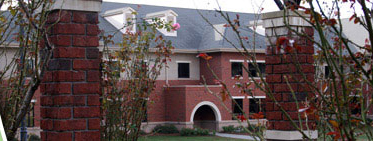Ravenscroft School
 Ravenscroft School in Raleigh is believed to have grown from an Episcopal parochial school begun in 1868. Befitting its association with Christ Church, the school was originally housed in the Sunday school rooms of a newly constructed building on the church grounds facing Capitol Square in downtown Raleigh. This school was, in part, a product of a bequest from Josiah Ogden West, who had died in 1852 but whose will provided a fund to employ a teacher for a parish school for Christ Church Raleigh. This parochial school continued operation at the site until at least 1891, after which it appears to have closed.
Ravenscroft School in Raleigh is believed to have grown from an Episcopal parochial school begun in 1868. Befitting its association with Christ Church, the school was originally housed in the Sunday school rooms of a newly constructed building on the church grounds facing Capitol Square in downtown Raleigh. This school was, in part, a product of a bequest from Josiah Ogden West, who had died in 1852 but whose will provided a fund to employ a teacher for a parish school for Christ Church Raleigh. This parochial school continued operation at the site until at least 1891, after which it appears to have closed.
A school named Ravenscroft-named in honor of John Stark Ravenscroft, first bishop of the Episcopal Diocese of North Carolina as well as the first rector of Christ Church-opened in the fall of 1937 using funds provided by West's will. Ravenscroft was an immediate success, part of its attraction being its nine-month school year versus the eight-month calendar of Raleigh's public schools. The Tucker Street school established the foundation for the modern institution as it implemented its philosophy of educating the whole child. Emphasis on the fine arts and athletics complemented academic pursuits, which were offered in small classes that featured much individual attention. The school prospered and expanded, with sixth and seventh grades being added by 1940.
The 1960s saw continued growth for Ravenscroft School, but Christ Church began to have internal financial troubles that would impact the school's future significantly. In 1966, seeking to avoid abandonment of the school by the financially troubled church, a group known as the Friends of Ravenscroft developed a plan that guaranteed the school's continued operation. The agreement provided for the transfer of the property at Tucker Street to the group while ending the church's responsibility.
Recognizing the changing nature of Raleigh occasioned by the development of Research Triangle Park, Ravenscroft's new board of trustees and its leader Robert Holding sought to implement a developing vision of a better, if costlier, school, whose expansion would necessitate relocation. In July 1968 Holding detailed a plan that called for Ravenscroft to become a top-quality college preparatory school, something he believed was needed in Raleigh. Later that year, responding to Holding's vision, the trustees purchased 115 acres of land on Falls of the Neuse Road, a spot that at the time was just at the northern end of the city's water and sewer lines.
Construction of the new temporary facility began in June 1969, and groundbreaking for the first permanent facility, the Middle School, took place in March 1970. That building, Edward N. Richards Hall, named for a long-time school supporter, was officially dedicated on 9 Jan. 1971. A torrent of construction projects followed. Upper and lower schools were followed by a sixth grade center and the A. E. Finley Activity Center, which included two gymnasiums as well as a swimming pool. The Robert P. Holding Jr. Memorial Garden, a gift from Holding's brother Lewis, was dedicated in 1988. Ravenscroft School, finally free of the debt incurred as a result of the move to the new campus, was a modern, first-rate academic institution in the early 2000s, with a student body of approximately 1,000.
Image Credit:
Ravenscroft School. Image available from the Ravenscroft website. Available from http://www.ravenscroft.org (accessed June 6, 2012).
Additional Resources:
Ravenscroft School: http://www.ravenscroft.org
1 January 2006 | Pruden, William H., III